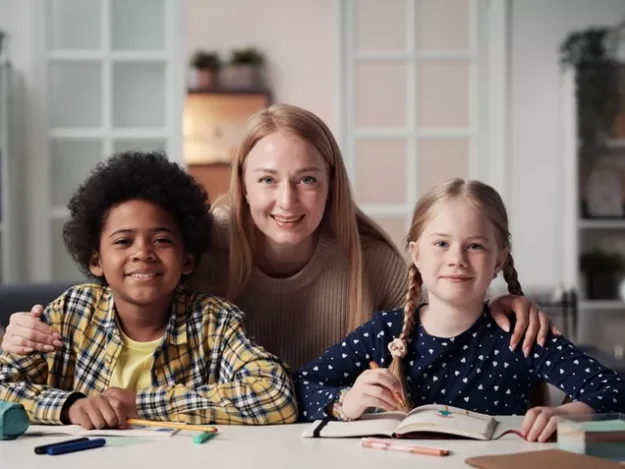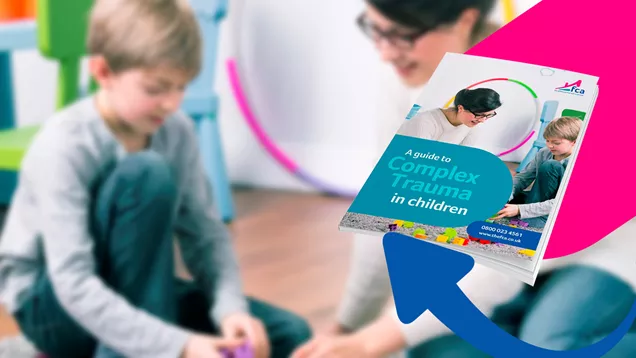First and foremost, a child who has experienced trauma needs to feel and know they are safe.
By welcoming a foster child who has suffered from trauma into your home you are providing that safe haven. As a foster parent, your role is to provide stability and a sense of normality for a child so that they can heal from past trauma and go on to lead happy, well-adjusted lives.
Remember that children react to trauma in different ways, with no right or wrong way of how they should behave when processing a traumatic event. As a foster parent, your children need to feel like they are safe to come to you with anything, even the bad things without fear.
Below, we’ll explore practical ways in which you can help a child suffering from trauma feel safe in your care and ways in which you can cultivate a positive and healthy relationship with them.
Tips for creating a safe place for your foster child

Prepare their bedroom
All children need a safe space where they can feel secure and have privacy. When preparing your spare room for your foster child’s arrival, make sure you create a space that they will be comfortable in. Try and find out what things they like in advance, such as books and toys so they have something familiar when they arrive.
Keep the noise to a minimum
Noise can be a stressor for many, especially children who have suffered from trauma. It may be that they have experienced traumatic experiences with loud noises such as shouting and abuse. Keeping general household noise to a minimum whenever you can will help reduce potential triggers and provide a more calming and relaxing environment for your foster child.
Establish and maintain routines
providing a predictable structure to a child’s day can help bring stability into their world and reduce their feelings of uncertainty. We all thrive from routines, and for children who have experienced upheaval and trauma, this is even more important. Try to establish consistent meal times and bedtimes, and set times for homework and family activities to help your foster child feel less anxious.
Set boundaries
Setting consistent age-appropriate boundaries is important to help children feel safe when their world seems otherwise out of control. Whilst it’s inevitable that they will test those limits be sure to give them lots of positive attention and praise when they do keep within the boundaries you have set.
Talk to other children in your home
If you have children of your own already, make sure you sit down and talk with them before a new child arrives to become part of the family. Let them talk about any concerns they have. It’s important that they know what to expect and to help ease their anxieties if there are any so they too feel ready to help a new foster child feel settled. Why not involve them in coming up with some fun things they could do to help welcome their new foster sibling.
How to help build healthy relationships
Although hugely rewarding, integrating a foster child into your home can come with its challenges. A child who has faced trauma may not have had a healthy relationship modelled to them, and therefore they may struggle to initially form a bond with you and your family. Take a look at some of the ways below in which you can help build a healthy relationship with a child in your care who has come from a traumatic background:

Listen to them
It’s essential to have open lines of communication with your foster child. Encourage them to ask questions and express their concerns. It’s important to let them know that their feelings are valid and that they have a safe space in which to open up and share these. However, remember it may take time for your child to feel ready to open up. Never push them to talk to you straight away if they aren’t ready, let them gradually open up in their own time.
Praise
Praise goes a long way with children as no child likes being told off. For children who have suffered attachment trauma in particular, this positive reinforcement is even more important to help them form a healthy bond. Even the smallest achievement should be rewarded and is a great way to build their self-esteem.
Build trust
One of the most important foundations of a healthy relationship is trust. This doesn’t come quickly, especially if your foster child has experienced past trauma. This takes time to build, but there are some things you can do to help earn their trust. Don’t make promises you can’t keep, and deliver on what you say so they know they can rely on you. Also, try and be as open as possible, sharing information about yourself to help them feel trusted.
Enjoy shared activities
Although it might sound obvious one of the best ways to bond with your foster child is to spend a lot of quality time together. This doesn’t have to be expensive days out, it can be activities such as crafting, reading, and playing together one-on-one. Due to the attachment trauma they may have suffered, your foster child may never have had that level of responsiveness before, so try and engage with them, taking time to enjoy shared activities they love together.
If you want to know more about trauma to understand how you can help a child in your care, download our Guide to Complex Trauma in Children. It’s got more information around trauma types, the effects, and common difficulties faced by foster children.
Or, if you’re thinking about starting a career in fostering or want to transfer to us, please get in touch. We’d love to answer any questions you have about FCA, the different types of foster care or any other questions you may have.

A Guide to Complex Trauma in Children
Download the FCA’s guide to Complex Trauma in Children. Get deeper insight and advice into understanding complex trauma in children.
